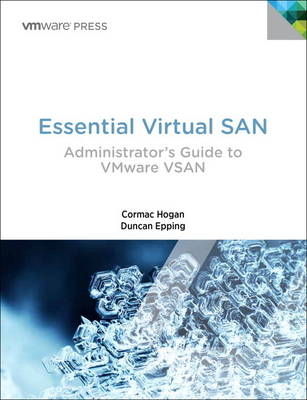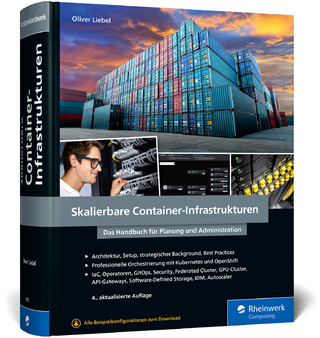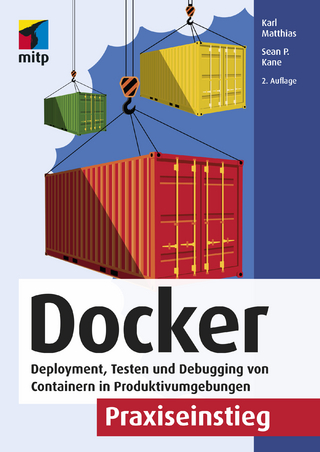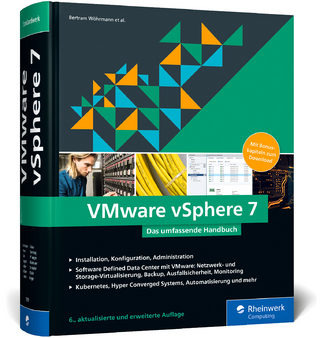
Essential Virtual SAN (VSAN)
VMWare Press (Verlag)
978-0-13-385499-2 (ISBN)
- Titel erscheint in neuer Auflage
- Artikel merken
Understand and implement VMware Virtual SAN: the heart of tomorrow’s Software-Defined Datacenter (SDDC)
VMware’s breakthrough Software-Defined Datacenter (SDDC) initiative can help you virtualize your entire datacenter: compute, storage, networks, and associated services. Central to SDDC is VMware Virtual SAN (VSAN): a fully distributed storage architecture seamlessly integrated into the hypervisor and capable of scaling to meet any enterprise storage requirement.
Now, the leaders of VMware’s wildly popular Virtual SAN previews have written the first authoritative guide to this pivotal technology. You’ll learn what Virtual SAN is, exactly what it offers, how to implement it, and how to maximize its value.
Writing for administrators, consultants, and architects, Cormac Hogan and Duncan Epping show how Virtual SAN implements both object-based storage and a policy platform that simplifies VM storage placement. You’ll learn how Virtual SAN and vSphere work together to dramatically improve resiliency, scale-out storage functionality, and control over QoS.
Both an up-to-the-minute reference and hands-on tutorial, Essential Virtual SAN uses realistic examples to demonstrate Virtual SAN’s most powerful capabilities. You’ll learn how to plan, architect, and deploy Virtual SAN successfully, avoid gotchas, and troubleshoot problems once you’re up and running.
Coverage includes
Understanding the key goals and concepts of Software-Defined Storage and Virtual SAN technology
Meeting physical and virtual requirements for safe Virtual SAN implementation
Installing and configuring Virtual SAN for your unique environment
Using Storage Policy Based Management to control availability, performance, and reliability
Simplifying deployment with VM Storage Policies
Discovering key Virtual SAN architectural details: caching I/O, VASA, witnesses, pass-through RAID, and more
Ensuring efficient day-to-day Virtual SAN management and maintenance
Interoperating with other VMware features and products
Designing and sizing Virtual SAN clusters
Troubleshooting, monitoring, and performance optimization
Cormac Hogan is a storage architect in the Integration Engineering team at VMware. Cormac was one of the first VMware employees at the EMEA headquarters in Cork, Ireland, back in 2005, and has previously held roles in VMware’s Technical Marketing and Support organizations. Cormac has written a number of storage-related white papers and has given numerous presentations on storage best practices and new features. Cormac is the owner of CormacHogan.com, a blog site dedicated to storage and virtualization. He can be followed on twitter @CormacJHogan. Duncan Epping is a principal architect working for VMware R&D. Duncan is responsible for exploring new possibilities with existing products and features, researching new business opportunities for VMware. Duncan specializes in software-defined storage, hyperconverged platforms, and availability solutions. Duncan was among the first VMware Certified Design Experts (VCDX 007). Duncan is the owner of Yellow-Bricks.com and author of various books, including the VMware vSphere Clustering Technical Deepdive series. He can be followed on twitter @DuncanYB.
Foreword by Ben Fathi xvii
Foreword by Charles Fan xix
About the Authors xxi
About the Technical Reviewers xxiii
Acknowledgments xxv
Reader Services xxvii
Introduction xxix
Chapter 1 Introduction to VSAN 1
Software-Defi ned Datacenter 1
Software-Defi ned Storage 2
Hyper-Convergence/Server SAN Solutions 3
Introducing Virtual SAN 4
What Is Virtual SAN? 5
What Does VSAN Look Like to an Administrator? 8
Summary 11
Chapter 2 VSAN Prerequisites and Requirements for Deployment 13
VMware vSphere 5.5 13
ESXi 5.5 U1 14
ESXi Boot Considerations 14
VSAN Requirements 15
VMware Hardware Compatibility Guide 15
VSAN Ready Nodes 15
Storage Controllers 16
Magnetic Disks 18
Flash Devices 19
Network Requirements 20
Network Interface Cards 20
Supported Virtual Switch Types 21
VMkernel Network 21
VSAN Network Traffi c 22
Jumbo Frames 22
NIC Teaming 23
Network I/O Control 23
Firewall Ports 23
Summary 24
Chapter 3 VSAN Installation and Confi guration 25
VSAN Networking 25
VMkernel Network for VSAN 26
VSAN Network Confi guration: VMware Standard Switch 27
VSAN Network Confi guration: vSphere Distributed Switch 28
Step 1: Create the Distributed Switch 28
Step 2: Create a Distributed Port Group 29
Step 3: Build VMkernel Ports 30
Possible Network Confi guration Issues 33
Network I/O Control Confi guration Example 35
Design Considerations: Distributed Switch and Network I/O Control 38
Scenario 1: Redundant 10GbE Switch Without “Link Aggregation” Capability 39
Scenario 2: Redundant 10GbE Switch with Link Aggregation Capability 42
Creating a VSAN Cluster 45
The Role of Disk Groups 45
Disk Group Maximums 46
Why Confi gure Multiple Disk Groups in VSAN? 46
SSD to Magnetic Disk Ratio 47
Automatically Add Disks to VSAN Disk Groups 48
Handling Is_local or Is_SSD Issues 48
Manually Adding Disks to a VSAN Disk Group 50
Disk Group Creation Example 50
VSAN Datastore Properties 53
Summary 53
Chapter 4 VM Storage Policies on VSAN 55
Introducing Storage Policy-Based Management in a VSAN Environment 56
Number of Failures to Tolerate 58
Number of Disk Stripes Per Object 59
Flash Read Cache Reservation 61
Object Space Reservation 61
Force Provisioning 61
VASA Vendor Provider 62
An Introduction to VASA 62
Storage Providers 63
VSAN Storage Providers: Highly Available 63
Changing VM Storage Policy On-the-Fly 64
Objects, Components, and Witnesses 68
VM Storage Policies 68
Enabling VM Storage Policies 69
Creating VM Storage Policies 70
Assigning a VM Storage Policy During VM Provisioning 70
Summary 71
Chapter 5 Architectural Details 73
Distributed RAID 73
Objects and Components 74
Component Limits 76
Virtual Machine Storage Objects 77
Virtual Machine Home Namespace 77
Virtual Machine Swap 78
VMDKs and Deltas 78
Witnesses and Replicas 79
Object Layout 79
VSAN Software Components 82
Component Management 83
Data Paths for Objects 83
Object Ownership 83
Placement and Migration for Objects 84
Cluster Monitoring, Membership, and Directory Services 85
Host Roles (Master, Slave, Agent) 85
Reliable Datagram Transport 86
On-Disk Formats 86
Flash Devices 86
Magnetic Disks 86
VSAN I/O Flow 87
The Role of the SSD 87
Anatomy of a VSAN Read 88
Anatomy of a VSAN Write 90
Retiring Writes to Magnetic Disks 91
Data Locality 91
Storage Policy-Based Management 92
VSAN Capabilities 92
Number of Failures to Tolerate Policy Setting 93
Best Practice for Number of Failures to Tolerate 95
Stripe Width Policy Setting 96
Striping on VSAN Outside of Policy Setting 98
Stripe Width Maximum 100
Stripe Width Confi guration Error 101
Stripe Width Chunk Size 102
Stripe Width Best Practice 102
Flash Read Cache Reservation Policy Setting 103
Object Space Reservation Policy Setting 103
VM Home Namespace Revisited 104
Swap Revisited 104
How to Examine the VM Swap Storage Object 104
Delta Disk / Snapshot Caveat 106
Verifying How Much Space Is Actually Consumed 106
Force Provisioning Policy Setting 107
Witnesses and Replicas: Failure Scenarios 107
Recovery from Failure 110
What About Stretching VSAN? 113
Summary 115
Chapter 6 VM Storage Policies and Virtual Machine Provisioning 117
Policy Setting: Number of Failures to Tolerate = 1 117
Policy Setting: Failures to Tolerate = 1, Stripe Width = 2 124
Policy Setting: Failures to Tolerate = 2, Stripe Width = 2 128
Policy Setting: Failures to Tolerate = 1, Object Space Reservation = 50 Percent 132
Policy Setting: Failures to Tolerate = 1, Object Space Reservation = 100 Percent 136
Default Policy 138
Summary 141
Chapter 7 Management and Maintenance 143
Host Management 143
Adding Hosts to the Cluster 143
Removing Hosts from the Cluster 145
ESXCLI VSAN Cluster Commands 145
Maintenance Mode 146
Recommended Maintenance Mode Option for Updates and Patching 148
Disk Management 149
Adding a Disk Group 149
Removing a Disk Group 150
Adding Disks to the Disk Group 152
Removing Disks from the Disk Group 153
Wiping a Disk 153
ESXCLI VSAN Disk Commands 154
Failure Scenarios 155
Magnetic Disk Failure 156
Flash Device Failure 157
Host Failure 158
Network Partition 159
Disk Full Scenario 164
Thin Provisioning Considerations 165
vCenter Management 166
vCenter Server Failure Scenario 167
Running vCenter Server on VSAN 168
Bootstrapping vCenter Server 168
Summary 171
Chapter 8 Interoperability 173
vMotion 174
Storage vMotion 174
vSphere HA 175
vSphere HA Communication Network 175
vSphere HA Heartbeat Datastores 176
vSphere HA Metadata 177
vSphere HA Admission Control 177
vSphere HA Recommended Settings 177
vSphere HA Protecting VSAN and Non-VSAN VMs 178
Distributed Resource Scheduler 178
Storage DRS 179
Storage I/O Control 179
Distributed Power Management 180
VMware Data Protection 180
Backup VMs from a VSAN Datastore Using VDP 181
Restore VMs to a VSAN Datastore Using VDP 181
vSphere Replication 183
Replicate to VSAN at a Recovery Site 183
Recover Virtual Machine 184
Virtual Machine Snapshots 185
vCloud Director 185
VMware Horizon View 186
VSAN Support for Horizon View 186
VM Storage Policies on VMware View 187
View Confi guration 187
Changing the Default Policy 190
Other View Considerations 190
vCenter Operations 191
vSphere 5.5 62TB VMDK 192
Fault Tolerance 192
Stretched/vSphere Metro Storage Cluster 193
PowerCLI 193
C# Client 193
vCloud Automation Service 193
Host Profi les 194
Auto-Deploy 194
Raw Device Mappings 195
vSphere Storage APIs for Array Integration 195
Microsoft Clustering Services 195
Summary 195
Chapter 9 Designing a VSAN Cluster 197
Sizing Constraints 197
Failures to Tolerate = 1, Stripe Width = 1 199
Flash to Magnetic Disk Ratio 200
Designing for Performance 201
Impact of the Disk Controller 202
VSAN Performance Capabilities 206
VMware View Performance 207
Design and Sizing Tools 208
Scenario 1: Where to Start 209
Determining Your Host Confi guration 211
Scenario 2 213
Determining Your Host Confi guration 215
Scenario 3 217
Determining Your Host Confi guration 218
Summary 220
Chapter 10 Troubleshooting, Monitoring, and Performance 221
ESXCLI 221
esxcli vsan datastore 222
esxcli vsan network 223
esxcli vsan storage 224
esxcli vsan cluster 226
esxcli vsan maintenancemode 227
esxcli vsan policy 228
esxcli vsan trace 230
Additional Non-ESXCLI Commands for Troubleshooting VSAN 231
Ruby vSphere Console 236
VSAN Commands 237
SPBM Commands 256
PowerCLI for VSAN 259
VSAN and SPBM APIs 261
Enable/Disable VSAN (Automatic Claiming) 261
Manual Disk Claiming 261
Change the VM Storage Policy 262
Enter Maintenance Mode 262
Create and Delete Directories on a VSAN Datastore 262
CMMDS 262
SPBM 263
Troubleshooting VSAN on the ESXi 263
Log Files 263
VSAN Traces 264
VSAN VMkernel Modules and Drivers 264
Performance Monitoring 265
ESXTOP Performance Counters for VSAN 265
vSphere Web Client Performance Counters for VSAN 266
VSAN Observer 267
Sample VSAN Observer Use Case 273
Summary 276
TOC, 9780133854992, 7/3/14
| Verlagsort | NJ |
|---|---|
| Sprache | englisch |
| Maße | 181 x 234 mm |
| Gewicht | 510 g |
| Themenwelt | Informatik ► Betriebssysteme / Server ► Virtualisierung |
| Mathematik / Informatik ► Informatik ► Datenbanken | |
| Mathematik / Informatik ► Informatik ► Netzwerke | |
| Informatik ► Weitere Themen ► Zertifizierung | |
| ISBN-10 | 0-13-385499-X / 013385499X |
| ISBN-13 | 978-0-13-385499-2 / 9780133854992 |
| Zustand | Neuware |
| Haben Sie eine Frage zum Produkt? |
aus dem Bereich



